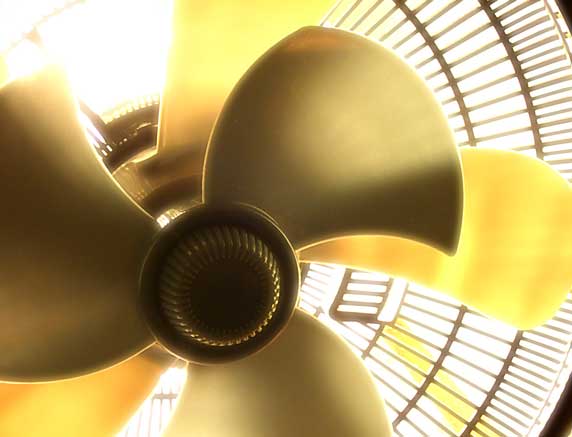 If you’ve ever watched one of those home improvement shows on TV, you are no doubt aware that the vast majority of interior designers think that a “fan” is either someone who follows them on social media, or an intrusive assault to the esthetic senses.
If you’ve ever watched one of those home improvement shows on TV, you are no doubt aware that the vast majority of interior designers think that a “fan” is either someone who follows them on social media, or an intrusive assault to the esthetic senses.
Well, no disrespect to the interior designers out there, but here’s the thing: in the summer months, a fan is an absolute necessity. In fact, depending on the size of your home, and in the absence of air conditioning, multiple fans are a necessity. But what makes one fan different from another? That’s what I’m here to tell you!
Bladed Fans
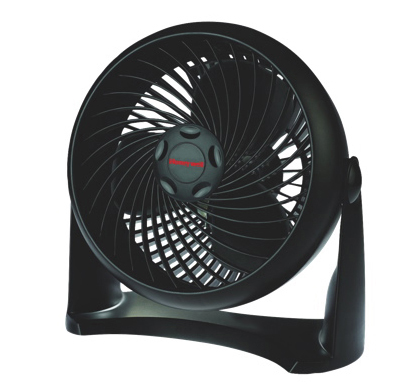 Before I dive in to what makes a bladed fan a bladed fan, I need to make note of the fact that I was absolutely positive that “bladed” wasn’t a word and was shocked when spell check didn’t flag it as incorrect. Clearly I was wrong, so watch out Words With Friends friends! But I digress. Blades, right. As far as fans are concerned, bladed fans are the ones with, well, blades. These are the fans you grew up with. The ones you’ve seen in homes, offices, ceilings, and restaurants for decades.
Before I dive in to what makes a bladed fan a bladed fan, I need to make note of the fact that I was absolutely positive that “bladed” wasn’t a word and was shocked when spell check didn’t flag it as incorrect. Clearly I was wrong, so watch out Words With Friends friends! But I digress. Blades, right. As far as fans are concerned, bladed fans are the ones with, well, blades. These are the fans you grew up with. The ones you’ve seen in homes, offices, ceilings, and restaurants for decades.
Similar to fanning yourself with a piece of paper, blades work by circulating air at a rapid pace to create a wind chill effect, which then works to cool you off. It’s important to note here that the size of the blades does matter. The bigger the blades, the more air is circulated, so while you don’t want a “tropical resort size” fan in your home, as a general rule, fans with skinny, or short blades don’t circulate air as well as those with fatter, longer blades. It’s also worth noting that there doesn’t seem to be any science behind whether or not more blades are better. In fact, if the motor is of a decent quality, three blades can be just as cooling, if not more so, than a fan with four or five blades.
Bladeless Fans
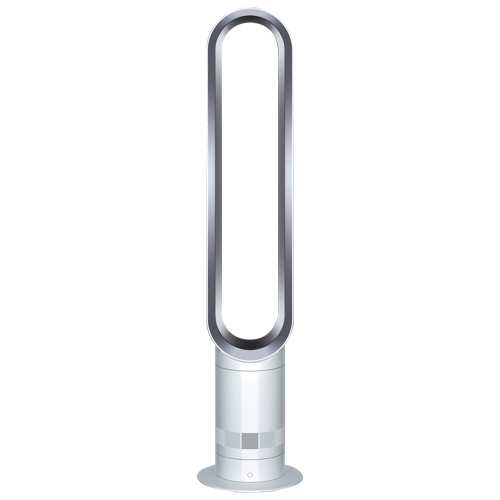 In recent years, fans without blades have become increasingly popular, like the Tower Fan from Dyson. Obviously, its lack of blades is what sets it apart from the masses, but how can a fan be a fan without the necessary blades? As you might imagine, it comes down to science, or perhaps a bit of magic. Let’s go with science. Bladeless fans work on the same aerodynamic principles as do jet planes. Perhaps not surprisingly, “bladeless” fans actually do have blades; they are just concealed in the base of the unit. The fan’s motor takes air in through vent holes and then forces that air out through the hollow hoop giving what some consider to be even more air circulation than a bladed fan.
In recent years, fans without blades have become increasingly popular, like the Tower Fan from Dyson. Obviously, its lack of blades is what sets it apart from the masses, but how can a fan be a fan without the necessary blades? As you might imagine, it comes down to science, or perhaps a bit of magic. Let’s go with science. Bladeless fans work on the same aerodynamic principles as do jet planes. Perhaps not surprisingly, “bladeless” fans actually do have blades; they are just concealed in the base of the unit. The fan’s motor takes air in through vent holes and then forces that air out through the hollow hoop giving what some consider to be even more air circulation than a bladed fan.
Taking things a step further, bladeless fans eliminate the buffeting that comes with bladed fans. If you don’t know what buffeting is, don’t worry; I had to Google it too. But it makes sense. Buffeting is the “pft-pft-pft” slapping sound that bladed fans make as their blades literally smack the air repeatedly. Bladeless fans eliminate buffeting entirely, and instead produce a soothing whir that is great at eliminating background noise when you’ve got your windows open, as is typically the case in the warmer months.
Stand and Countertop Fans
In the process of writing this post I’ve realized that I actually have three different types of fans running at the same time; don’t judge me … it’s the west coast in <almost> summer and it is hot and humid! I’ve got a ceiling fan going full tilt in my dining room, a standing fan cooling my living room, and a countertop fan keeping my kitchen as cool as possible while I bake some chicken and potatoes. Outside of the miniature portable fans you might see tourists toting around with them on Canada Day, these three—ceiling, stand, and countertop—are the fan trifecta. Ceiling fans are pretty much self explanatory, but the difference between countertop and stand fans can be a little more subtle.
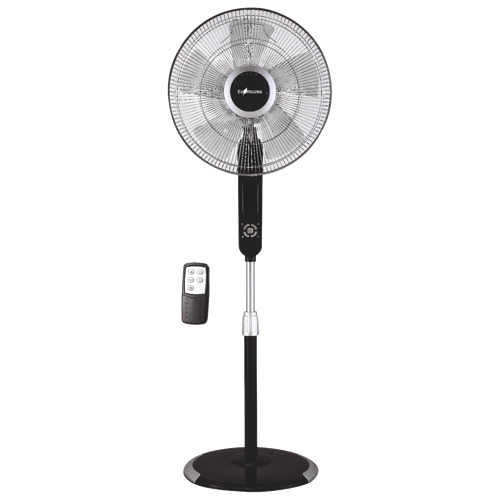 Stand fans tend to be larger and taller, and often come with a little more power than their smaller countertop counterparts. Stand fans like Ecohouzng’s 16” Digital Oscillating Stand Fan are ideal for mid to larger sized rooms as their bigger blades can chill the air to a wider area. They are also typically vertically adjustable and oscillating so you can position the airflow to a specific spot in your living room, den, or bedroom, and reap all the benefits of cooler air.
Stand fans tend to be larger and taller, and often come with a little more power than their smaller countertop counterparts. Stand fans like Ecohouzng’s 16” Digital Oscillating Stand Fan are ideal for mid to larger sized rooms as their bigger blades can chill the air to a wider area. They are also typically vertically adjustable and oscillating so you can position the airflow to a specific spot in your living room, den, or bedroom, and reap all the benefits of cooler air.
Countertop fans on the other hand are smaller, better suited to smaller spaces, and are typically a little more portable. What I mean by that is while stand fans can be toted from room to room, countertop fans can be toted from room to room without the need for floor space. When I look at my whole one-bedroom apartment situation, this is a big deal. I can move my countertop fan from the kitchen counter to the dresser in my bedroom so I am guaranteed to sleep in chilly splendor. I can also move it to my bathroom so I can blow-dry and straighten my hair without breaking the same kind of sweat I would have had I just hiked a mountain in the heat of the day. To lug my heavy stand fan from my living room to my bedroom on a daily basis is absolutely doable, just not ideal.
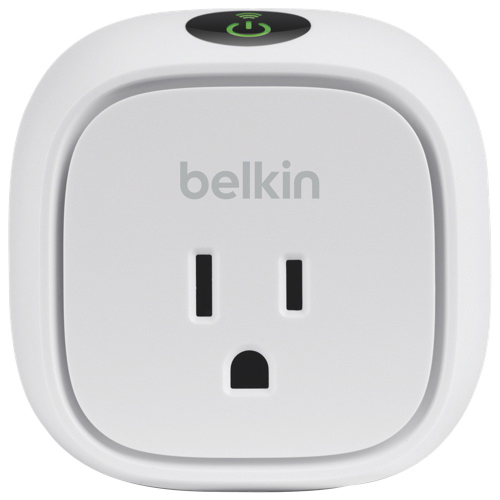
Smart Fans
Blades, no blades, countertop, stand; let’s be honest here folks … these days anything that is “smart” is awesome. That said, the current inventory of smart fans is somewhat limited; although I suspect by this time next year that will change. In the meantime you can make any fan in your home “smart” by using a programmable outlet like the WeMo Insight Switch or the WeMo WiFi Switch from Belkin. With these ridiculously handy gadgets, you can turn your fans on or off regardless of where you might be all through an easy to use app on your smartphone.
You can also go the route of a programmable thermostat like the fantastically smart Nest Learning Thermostat. With this bad boy you can control the temperature of your home from afar so you aren’t faced with the unpleasantness that comes with walking into a sauna after a hard day at a blissfully air conditioned office. At the very least, if you forget to monitor the temperature of your home throughout the day, you can check in via the Nest app to see just how stifling your home might be; then, you can schedule a quick visit to Best Buy on your way home to purchase a new fan, because let’s be honest—you’re going to need it!



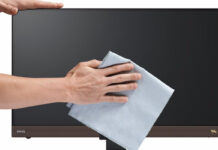
The airflow in my office cubicle is kinda stagnant when the summer heat comes. I’ve since discovered USB fans. Put one or two of these tiny babies around for instant comfort. Works great when a neighbor’s desktop dining food odours bother you when you are trying to diet…
http://www.bestbuy.ca/en-CA/product/logiix-logiix-retro-air-6-usb-desk-fan-lgx-10672-black-lgx-10672/10266206.aspx
Note, some offices discourage staff from plugging in 120v personal heaters and fans in their cubicles. Current overload? Fire possibility? I think USB devices draw too little current to cause a concern. Just fill those USB ports!!!
Comments are closed.